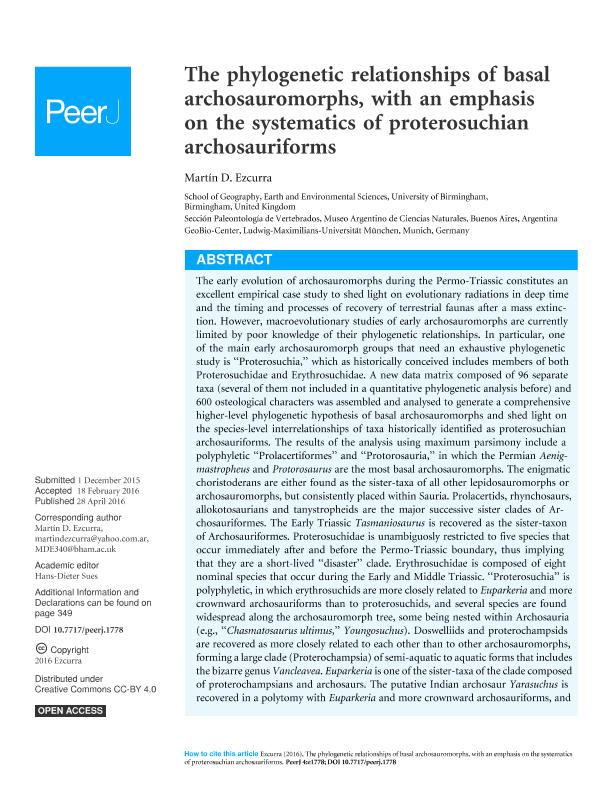Mostrar el registro sencillo del ítem
dc.contributor.author
Ezcurra, Martin Daniel

dc.date.available
2018-05-29T22:38:57Z
dc.date.issued
2016-04
dc.identifier.citation
Ezcurra, Martin Daniel; The phylogenetic relationships of basal archosauromorphs, with an emphasis on the systematics of proterosuchian archosauriforms; PeerJ; PeerJ; 4; 4-2016; 1-385; e1778
dc.identifier.issn
2167-8359
dc.identifier.uri
http://hdl.handle.net/11336/46557
dc.description.abstract
The early evolution of archosauromorphs during the Permo-Triassic constitutes an excellent empirical case study to shed light on evolutionary radiations in deep time and the timing and processes of recovery of terrestrial faunas after a mass extinction. However, macroevolutionary studies of early archosauromorphs are currently limited by poor knowledge of their phylogenetic relationships. In particular, one of the main early archosauromorph groups that need an exhaustive phylogenetic study is “Proterosuchia,” which as historically conceived includes members of both Proterosuchidae and Erythrosuchidae. A new data matrix composed of 96 separate taxa (several of them not included in a quantitative phylogenetic analysis before) and 600 osteological characters was assembled and analysed to generate a comprehensive higher-level phylogenetic hypothesis of basal archosauromorphs and shed light on the species-level interrelationships of taxa historically identified as proterosuchian archosauriforms. The results of the analysis using maximum parsimony include a polyphyletic “Prolacertiformes” and “Protorosauria,” in which the Permian Aenigmastropheus and Protorosaurus are the most basal archosauromorphs. The enigmatic choristoderans are either found as the sister-taxa of all other lepidosauromorphs or archosauromorphs, but consistently placed within Sauria. Prolacertids, rhynchosaurs, allokotosaurians and tanystropheids are the major successive sister clades of Archosauriformes. The Early Triassic Tasmaniosaurus is recovered as the sister-taxon of Archosauriformes. Proterosuchidae is unambiguosly restricted to five species that occur immediately after and before the Permo-Triassic boundary, thus implying that they are a short-lived “disaster” clade. Erythrosuchidae is composed of eight nominal species that occur during the Early and Middle Triassic. “Proterosuchia” is polyphyletic, in which erythrosuchids are more closely related to Euparkeria and more crownward archosauriforms than to proterosuchids, and several species are found widespread along the archosauromorph tree, some being nested within Archosauria (e.g., “Chasmatosaurus ultimus,” Youngosuchus). Doswelliids and proterochampsids are recovered as more closely related to each other than to other archosauromorphs, forming a large clade (Proterochampsia) of semi-aquatic to aquatic forms that includes the bizarre genus Vancleavea. Euparkeria is one of the sister-taxa of the clade composed of proterochampsians and archosaurs. The putative Indian archosaur Yarasuchus is recovered in a polytomy with Euparkeria and more crownward archosauriforms, and as more closely related to the Russian Dongusuchus than to other species. Phytosaurs are recovered as the sister-taxa of all other pseudosuchians, thus being nested within Archosauria.
dc.format
application/pdf
dc.language.iso
eng
dc.publisher
PeerJ
dc.rights
info:eu-repo/semantics/openAccess
dc.rights.uri
https://creativecommons.org/licenses/by-nc-sa/2.5/ar/
dc.subject
Diapsida
dc.subject
Archosauromorpha
dc.subject
Permian
dc.subject
Cladistics
dc.subject
Archosauria
dc.subject
Phylogeny
dc.subject
Triassic
dc.subject
Macroevolution
dc.subject.classification
Meteorología y Ciencias Atmosféricas

dc.subject.classification
Ciencias de la Tierra y relacionadas con el Medio Ambiente

dc.subject.classification
CIENCIAS NATURALES Y EXACTAS

dc.title
The phylogenetic relationships of basal archosauromorphs, with an emphasis on the systematics of proterosuchian archosauriforms
dc.type
info:eu-repo/semantics/article
dc.type
info:ar-repo/semantics/artículo
dc.type
info:eu-repo/semantics/publishedVersion
dc.date.updated
2018-05-24T14:25:52Z
dc.journal.number
4
dc.journal.pagination
1-385; e1778
dc.journal.pais
Estados Unidos

dc.description.fil
Fil: Ezcurra, Martin Daniel. Consejo Nacional de Investigaciones Científicas y Técnicas. Oficina de Coordinación Administrativa Parque Centenario. Museo Argentino de Ciencias Naturales "Bernardino Rivadavia"; Argentina
dc.journal.title
PeerJ
dc.relation.alternativeid
info:eu-repo/semantics/altIdentifier/doi/https://dx.doi.org/10.7717/peerj.1778
dc.relation.alternativeid
info:eu-repo/semantics/altIdentifier/url/https://peerj.com/articles/1778/
dc.relation.alternativeid
info:eu-repo/semantics/altIdentifier/url/https://www.ncbi.nlm.nih.gov/pmc/articles/PMC4860341/
Archivos asociados
